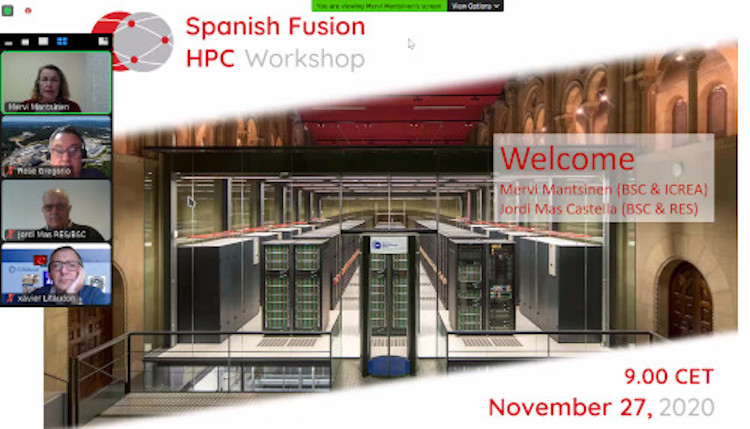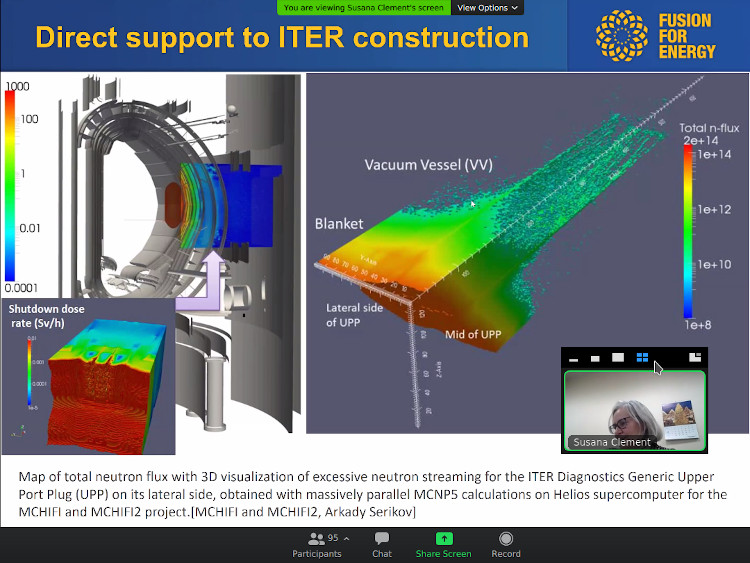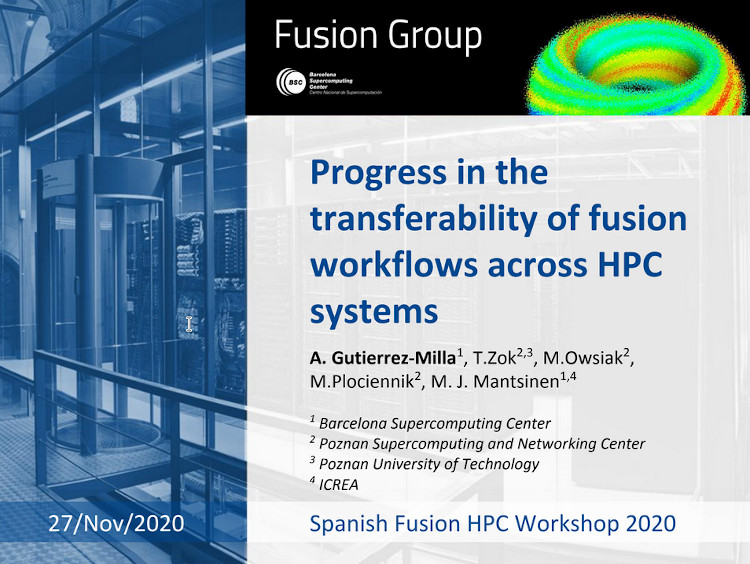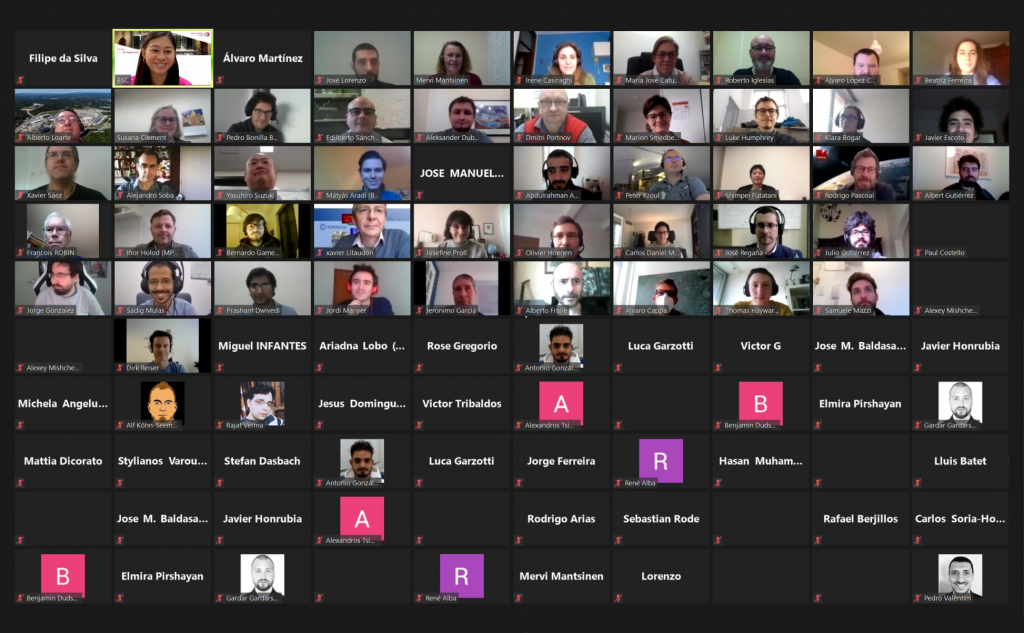
On November 27th, the 1st Spanish Fusion HPC Workshop (link to full programme and abstracts) was organized online by our Fusion group and Barcelona Supercomputing Center (BSC) in close collaboration with the Spanish Supercomputing Network (RES) and experts from several collaborator institutes. A total of 182 registered attendants interested in the modelling in fusion met in this online event which delved both into the overall progress and challenges of High Performing Computing (HPC) applied to large scale fusion projects such as ITER or EUROfusion, and into specific research on most types of fusion phenomena simulations (energy and particle transport, fast particles, multi-physics, plasma, deep learning, materials micro-structure, preconditioning, HPC systems resources and transferability across HPC systems, etc.).
Prof. Mervi Mantsinen, ICREA researcher, PI of FusionCAT project and leader of our Fusion group at the BSC, welcomed the participants at 9:00h and chaired the plenary talks. Firstly, Dr. Alberto Loarte, Head of ITER Science division talked about the role of HPC in supporting ITER’s Research Plan and modelling needs. He showed applications modelling the fusion reaction and plasma evolution, but also practicalities such as checking the feasibility to clean depositions forcing some plasma mode flows. Secondly, Dr. Susana Clement, Deputy Head Of Department at Fusion for Energy (F4E) followed by expanding the scope of HPC role within the Broader Approach activities. In particular, she shared the lessons learnt from HELIOS supercomputer completed life service, the most relevant simulations run in it and future plans of IFERC‘s Computational Simulation Centre (CSC). After the first parallel session, Dr Xavier Litaudon, Head of EUROfusion ITER physics summarized the role of HPC within the EUROfusion Theory and Advanced Simulation Coordination (E-TASC) program included in Horizon Europe and adhered to the European Fusion Roadmap. The last plenary speaker was Dr. Jordi Mas (BSC) who illustrated the HPC resources available at RES and Partnership for Advance Computing in Europe (PRACE).

Six of the invited speakers filled the first set of parallel sessions. The session chaired by Dr. Shimpei Futatani (UPC) started with Dr Jeronimo García (CEA) presenting how HPC simulations with GENE code have given insight into the impact of Alfvén Eingemodes (AE) in turbulence reduction on the ion gyroradious scale. This high impact was confirmed experimentally at JET and its understanding will enable ion thermal energy increase in plasmas. Next, Prof. Yasuhiro Suzuki (NIFS) shared his advances simulating core plasma collapse events by means of HPC nonlinear Magnetohydrodynamics (MHD). The codes used were HINT and MIPS, while the experimental data was taken from W7-X with the aim to accurately describe instability onsets on the iota profile and magnetic field topological changes during the crash. The talk by Dr. Ihor Holod (MPCDF) closed the session demonstrating the benefits of a new advanced GMRES pre-conditioner designed for nonlinear MHD, and implemented in JOREK code. The pre-conditioner exploits individual toroidal harmonics and the so-called mode families. It was tested in edge-localized mode disruptions and vertical displacement events.

The parallel session chaired by Prof. Mantsinen started with Dr. María J. Caturla (University of Alicante) outlining all HPC simulation tools used to model Fe and Fe-based alloys from a multi-scale approach. This included results of micro-structure evolution to transmission electron microscopy (TEM) or atom probe tomography (APT), among other experimental methodologies. Afterwards, Prof. Javier J. Honrubia (UPM) talked about several multi-dimensional radiation hydrodynamics, Particle-In-Cell and hybrid simulations of fast ignition of imploded Inertial Confinement Fusion capsules, conducted at MareNostrum and Magerit. In these problems, separating fuel compression from the ignition requires HPC due to the multiple timescales involved. The session concluded with Prashant Dwivedi (CTU) presenting his group’s work on simulation of molecular dynamics in the scope of hyper-velocity impact and damage initiation. The used HPC model accounts for massive plastic deformation, breakup, melting and vaporization of Tungsten projectiles and targets.
The remaining four invited speakers led the afternoon parallel sessions which were completed with 10 contributed talks (link to full programme and abstracts) and were chaired by Dr. Edilberto Sanchez (CIEMAT) and Dr. Alejandro Soba (CONICET). In them, Dr. José Manuel García Regaña (CIEMAT) presented his nonlinear simulations of gyrokinetic turbulent transport of impurities in multi-species stellarator plasmas with the stella code and W7-X data. Dr. Albert Gutierrez-Milla (BCS fusion group) exposed the benefits of packaging Docker container images of ITER Integrated Modelling & Analysis Suite, which can be transferred to other HTC systems (Marconi in the results, MareNostrum 4 and Eagle in progress) with good performance. Dr. Alexey Mishchenko (MPIPP) talk covered the improvements introduced by the “control-variate mitigation technique” and the “pullback transformation scheme” in several global gyrokinetic particle-in-cell HPC codes (EUTERPE, GYGLES, ORB5 and XGC). Dr. Jesús Dominguez-Palacios (Universidad de Sevilla) showed the first 3D non-linear hybrid kinetic-MHD simulations of edge localized modes in the presence of energetic particles (obtained with the MEGA code) and the impact of the described interaction between ELMs and fast ions.

Regarding the most popular talk award sponsored by BSC and our group selected by voting in the closing session, the three winners in the alphabetical order are Dr. Maria J. Caturla, Dr. Jerónimo García and Dr. Jonathan Shimwell. Details of the two firsts invited talks can be found in the paragraphs above. Dr. Jonathan Shimwell (CCFE)‘s contributed talk delved into the capabilities of Paramak python package in the iterative automated model building and analysis of fusion reactors. The parametric 3D CAD geometries produced are directly linked to neutronics, being the main input parameters: continuous ranges such as blanket thickness, integer ranges such as number of toroidal field coils and categorical parameters such as type of divertor.
Prof. Mantsinen closed the meeting with sincere thanks to all the speakers, both the programme and the local organizing committee, the institutions involved and all the participants. We look forward to the next edition which we hope to organize in person in Barcelona with kind sponsorship by RES when the situation allows it.
See you next time!
